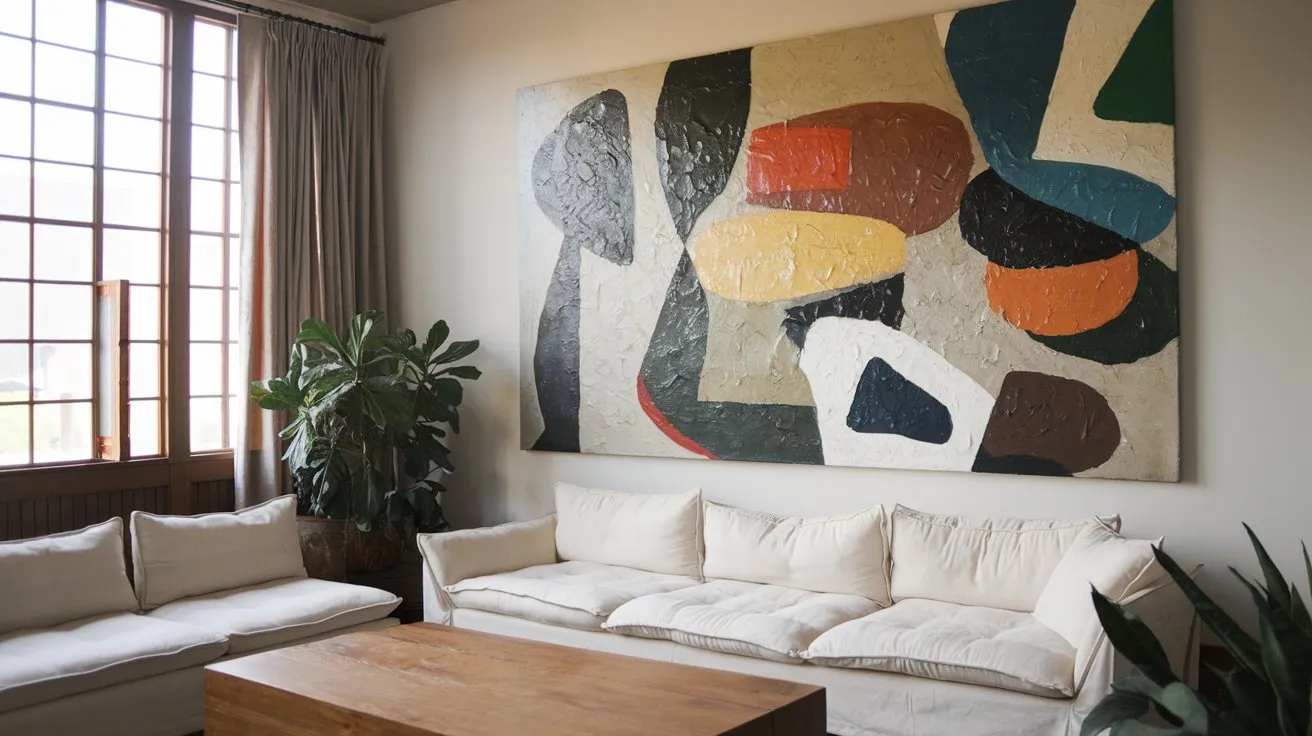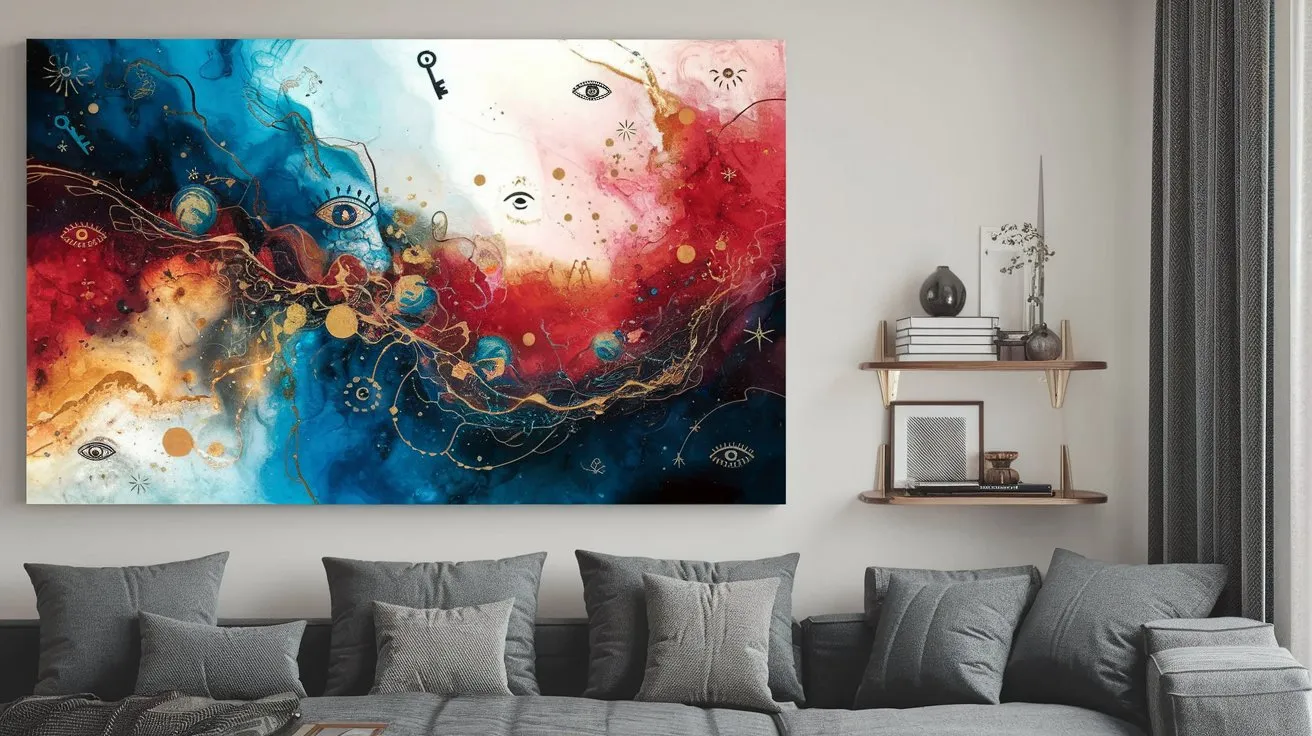Have you ever stood before an abstract painting, captivated but confused, sensing something profound yet struggling to define it? If so, you’re not alone. Abstract Meaning art, with its expressive forms, enigmatic colors, and boundless creativity, speaks a language beyond words. Unlike traditional forms of art that depict recognizable subjects, abstract art invites you to interpret shapes, colors, and textures in ways unique to you. This journey of decoding hidden meanings within abstract art isn’t about finding a single truth but about discovering what resonates personally.

In this guide, we’ll explore ways to interpret abstract Meaning art, understand common themes and symbols, and offer practical steps to uncover the deeper layers of meaning that lie within these captivating works. Let’s begin unlocking the mysteries of abstract art.
Table of Contents
What is Abstract Art and Why is it Meaningful?
To start your exploration, it helps to understand what abstract Meaning art is and why it holds so much depth. Abstract Meaning art, at its core, defies traditional representation. It doesn’t try to replicate the world literally. Instead, it embraces forms, colors, and patterns to evoke emotions and ideas.
The genre gained popularity in the early 20th century with artists like Wassily Kandinsky and Jackson Pollock, who broke away from realistic portrayals to explore the power of pure form and color. Abstract Meaning art can be purely emotional or intellectual, reflecting everything from an artist’s personal struggles to broad philosophical themes. By removing clear subjects, abstract Meaning art leaves room for you, the viewer, to engage and find your own interpretation.
Why Abstract Art Has Hidden Meanings

Unlike literal artworks, abstract Meaning art pieces often carry hidden layers of meaning crafted by the artist but also shaped by your perspective. Artists may embed personal stories, social commentaries, or spiritual elements into abstract forms. The symbols they choose, the colors they emphasize, and the flow of the lines they create all contribute to a message that is rarely straightforward.
Abstract Meaning art is open to interpretation, and this is what makes it special. It invites you to ask questions, to be curious, and to engage with what you see on a personal level. The artist’s intent might offer one layer of meaning, but your experience and emotional state add another, making every viewing unique.
Steps to Discover Hidden Meanings in Abstract Art
Ready to dive deeper? Here are several steps to help you interpret abstract art with fresh eyes and an open mind.
1. Observe Without Judgment
One of the most important things to do when approaching abstract art is to observe it without trying to analyze it right away. Let go of the urge to “figure it out” instantly. Instead, take a few minutes to simply look at the piece and absorb it as a whole. Allow yourself to be drawn to specific areas of the artwork.
Ask yourself:
- What feelings arise when you look at this piece?
- Does any part of it stand out more than others?
Your initial impressions are valuable clues in understanding what the art might mean to you.
2. Identify the Key Elements: Colors, Shapes, and Lines
Abstract Meaning art often relies heavily on colors, shapes, and lines to convey emotion. Here’s how each element might guide your interpretation:
- Colors: Colors in abstract Meaning art can evoke a range of emotions. For instance, warmer colors like reds and oranges may suggest energy, passion, or warmth, while cooler colors like blues and greens might evoke calmness or melancholy.
- Shapes: Certain shapes can hold symbolic meanings. Circles often represent unity or infinity, while squares can denote stability. The absence of clear shapes might represent fluidity or chaos.
- Lines: The direction and weight of lines can tell a story. Jagged lines might suggest tension or conflict, while soft, curving lines may evoke tranquility.
Each element offers clues, but there’s no single “right” way to interpret them. Abstract Meaning art is designed to invite different perspectives.
3. Consider the Composition and Space
Composition plays a major role in abstract art. The arrangement of elements how they interact with space often hints at the artwork’s mood and energy.
For example:
- If the elements are tightly packed together, it may evoke a sense of tension or intensity.
- Large, open spaces can give a feeling of freedom or isolation.
By examining the composition, you can gain insight into how the artist intended for the piece to “feel” to viewers. Ask yourself: does the layout make you feel cramped, calm, or uplifted?
4. Explore the Historical and Personal Context
Understanding the context behind an artwork can reveal deeper meanings. Researching the time period, cultural backdrop, or personal experiences of the artist can help illuminate the work. Some abstract pieces are responses to political events, social issues, or personal struggles.
For example, the works of Mark Rothko are known for their emotional depth, influenced by his experiences and reflections on human existence. Knowing these elements can enhance your understanding and bring you closer to the artwork’s intended message.
5. Common Symbols and Themes in Abstract Art
Many abstract works include recurring themes or symbols. Here’s a quick reference table with some common symbols in abstract art and what they might represent:
| Symbol/Element | Possible Meanings |
|---|---|
| Circles | Unity, wholeness, cycles |
| Lines | Energy, direction, tension |
| Warm colors | Passion, vitality, warmth |
| Cool colors | Calm, introspection, melancholy |
| Empty spaces | Freedom, isolation, emptiness |
| Geometric shapes | Structure, logic, order |
Keep in mind that these symbols aren’t definitive; they’re starting points. Abstract art allows for multiple interpretations, so use this as a guide, not a strict rule.
6. Reflect on Your Own Emotions and Experiences
Your personal history and emotions shape how you see abstract art. Because abstract art is open-ended, it acts as a mirror, reflecting parts of you. Consider how your own memories, mood, and personality influence your reaction to a piece.
For instance, if you’re drawn to turbulent compositions with intense colors, it might reflect something in your current emotional state. Embracing your unique perspective allows you to find personal meaning in abstract art.
Exercises to Practice Finding Meaning in Abstract Art
Ready to take your abstract art interpretation skills to the next level? Try these simple exercises:
1. Describe Your Emotional Reaction
Spend a few moments in front of an abstract piece, and jot down the emotions it evokes. Don’t worry about analyzing why just focus on capturing your initial response. This can help you connect more personally with the art.
2. Focus on One Element at a Time
Choose one element like color, line, or shape and concentrate on interpreting just that part of the artwork. This can help you break down complex compositions and make sense of them piece by piece.
3. Imagine Different Perspectives
Try viewing the piece from a new perspective, such as imagining how a child or someone from a different culture might interpret it. This exercise can open your mind to other possible interpretations and deepen your appreciation of the work’s layers.
FAQ: Understanding Abstract Meaning in Art
What is the purpose of abstract art?
Abstract art aims to evoke emotions and invite viewers to engage in personal interpretation. It emphasizes form and color over direct representation, offering a visual experience that transcends the literal.
Is there always a hidden meaning in abstract art?
Not necessarily. While some artists create abstract works with specific meanings, others prefer to leave them open-ended, allowing each viewer to bring their interpretation.
How can I improve my ability to interpret abstract art?
Practice observing abstract art without judgment and pay attention to your emotional responses. Familiarize yourself with common symbols and study the artist’s background for added context.
Why do people see different meanings in the same abstract art piece?
Each viewer brings their own experiences, feelings, and perspective, which can shape their interpretation. Abstract art is intentionally open, encouraging diverse interpretations.
Conclusion – Embrace the Mystery of Abstract Art
As you’ve seen, interpreting abstract art is less about finding a “right” answer and more about discovering what resonates with you personally. The beauty of abstract art lies in its mystery and the freedom it gives you to see with your heart, not just your eyes.
So, the next time you stand before an abstract piece, approach it with curiosity and patience. Let it speak to you in its unique, silent language. Trust your instincts and let your interpretation evolve. Whether it’s a feeling of peace, a sense of wonder, or a challenge to see things differently, abstract art has a way of reaching you if only you’re open to the experience.
Call-to-Action:
Explore your local art gallery or online collections with these new insights, and see what hidden meanings you uncover. Share your experiences, interpretations, or newfound love for abstract art with friends and fellow art enthusiasts. Let the journey of abstract art add depth and reflection to your own life.
